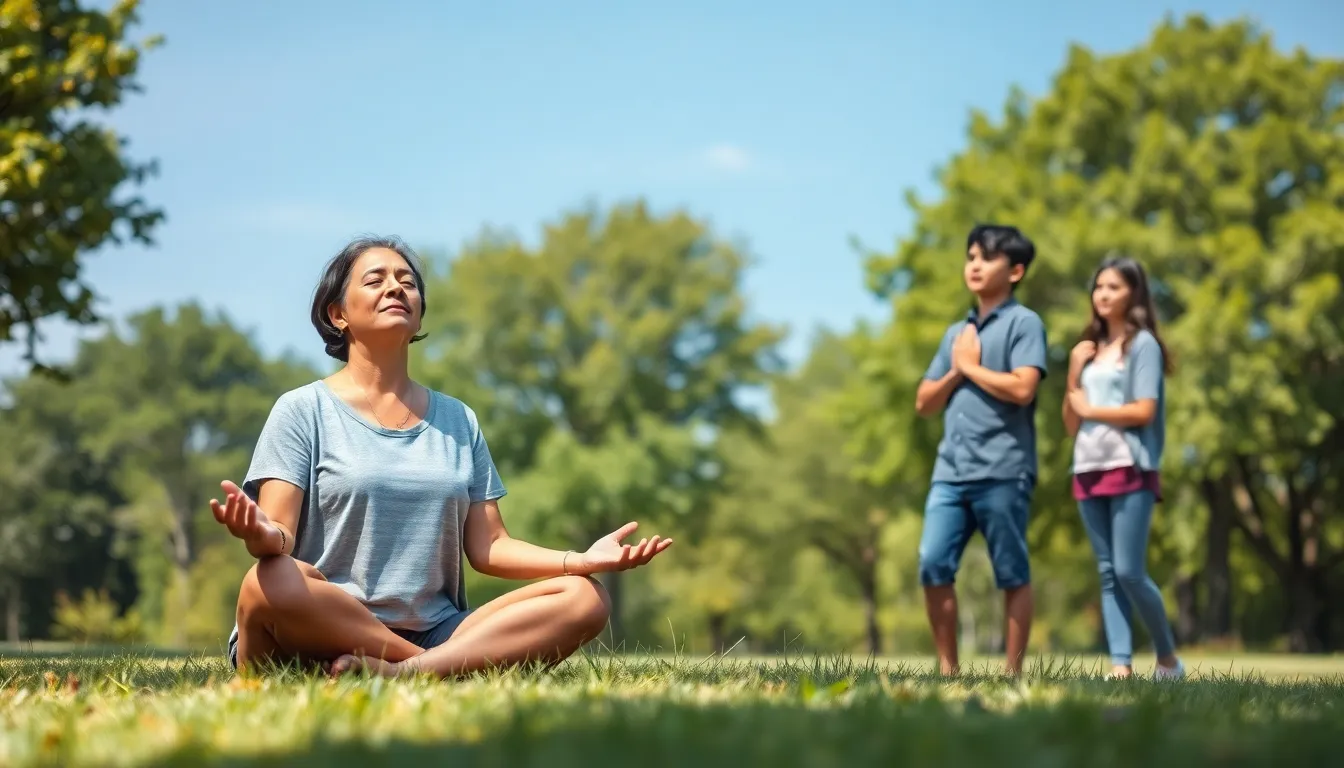Table of Contents
ToggleIn a world buzzing with distractions and chaos, grounding techniques are like a cozy blanket on a chilly day. These simple strategies help individuals reconnect with the present moment, making it easier to navigate life’s ups and downs without feeling like they’re on a rollercoaster. Who wouldn’t want a toolkit for emotional balance that’s as easy to use as a remote control?
Overview Of Grounding Techniques
Grounding techniques serve as effective tools to foster emotional balance amid chaos. These strategies help individuals reconnect with the present moment, making it easier to manage stress and anxiety. Various methods exist, each designed to cater to different preferences and situations.
Breathing exercises form one of the simplest grounding techniques. They encourage focus on the breath, which calms the nervous system. Techniques like the 4-7-8 method involve inhaling for four counts, holding for seven, and exhaling for eight.
Physical grounding techniques emphasize the senses. Touching different textures or listening to ambient sounds enhance awareness of the surrounding environment. Engaging with nature, such as feeling grass or water, also grounds individuals effectively.
Mindfulness practices promote awareness of thoughts and feelings without judgment. Activities like meditation, focused attention, and body scans contribute to a deeper connection with one’s self. These practices encourage acceptance of current emotions while fostering a sense of safety.
Visualization offers another approach. Imagining a safe place or recalling a comforting memory can create a mental sanctuary in times of distress. Such techniques often serve to counter negative emotions by redirecting focus.
Establishing a routine can ground individuals throughout the day. Consistent habits create a structured environment that provides comfort. Engaging in activities like journaling or exercise promotes predictability and stability.
In essence, grounding techniques encompass a wide array of strategies. Each method aids individuals in returning to the present moment and managing emotional challenges effectively. Utilizing these techniques encourages emotional resilience and enhances overall well-being.
Benefits Of Grounding Techniques

Grounding techniques offer significant benefits that enhance overall well-being. They promote mental clarity and emotional stability, making it easier to handle daily stresses.
Improved Mental Health
Grounding techniques significantly contribute to improved mental health. They diminish feelings of anxiety and foster a sense of calm. Techniques like deep breathing effectively activate the body’s relaxation response. Evidence shows that incorporating these methods leads to reduced symptoms of depression and anxiety disorders. Participants who practice grounding report fewer mood fluctuations and increased emotional resilience. Engaging in mindfulness exercises also helps cultivate positive thinking patterns. Regular use of these techniques supports better focus on tasks and aids in emotional recovery during challenging situations.
Enhanced Emotional Regulation
Enhanced emotional regulation results from consistent grounding practice. Techniques such as body awareness and sensory engagement allow individuals to recognize their feelings. Responding to emotions rather than reacting impulsively becomes achievable. Research indicates that grounding can mitigate emotional overwhelm and facilitate better decision-making. When individuals employ these strategies, they often experience decreased levels of stress and improved coping mechanisms. Regular use encourages a balanced emotional state and fosters healthier relationships. Individuals can navigate conflicts with greater ease and maintain emotional stability, further illustrating the benefits of grounding techniques.
Common Grounding Techniques
Grounding techniques can effectively bring focus back to the present. These methods vary, addressing both physical and mental aspects for a comprehensive approach to emotional balance.
Physical Grounding Techniques
Physical grounding techniques involve engaging the senses to anchor individuals to their environment. Techniques such as deep breathing enhance oxygen flow, promoting calmness. Using tactile sensations like holding an object or touching a textured surface brings attention to the present. Moving through nature connects individuals with the earth and offers soothing sensory experiences. Other examples include stretching or performing simple exercises that release tension. Embracing these methods fosters awareness of one’s own body and surroundings, reinforcing a sense of safety and calm.
Mental Grounding Techniques
Mental grounding techniques emphasize shifting thoughts away from distressing emotions. Practicing visualization allows individuals to create serene mental images, transporting them to peaceful places. Counting backward from 100 or reciting familiar facts redirects thoughts, creating mental clarity. Engaging in mindfulness meditation cultivates acceptance and acknowledgment of feelings without judgment. Journaling prompts reflection, providing an outlet for processing thoughts and emotions. Each of these methods contributes to emotional regulation, enhancing resilience against stressors and anxiety.
How To Incorporate Grounding Techniques Into Daily Life
Incorporating grounding techniques into daily life enhances emotional balance. Simple practices can make a significant impact.
Tips For Practicing Grounding Techniques
Start with deep breathing exercises. Engaging in five to ten deep breaths calms the nervous system and promotes relaxation. Utilize the five senses to anchor oneself to the present moment. Notice the sights, sounds, textures, tastes, and smells in the environment. Establish routines that include grounding activities. Scheduling these moments creates predictability and reinforces a sense of stability. Mix up techniques to find what resonates best. Experimentations lead to the most effective personal practices.
Grounding Techniques For Stress Relief
Regular mindfulness meditation proves beneficial. Practicing mindfulness cultivates awareness of thoughts and feelings, helping individuals remain present. Visualization techniques can offer comfort. Imagining a calming place creates a mental sanctuary during stressful moments. Engaging in physical activities provides additional relief. Going for a walk in nature or practicing yoga connects the body and mind. Journaling thoughts fosters clarity. Writing down emotions allows for reflection and processing, reducing stress levels.
Grounding techniques offer valuable tools for navigating emotional challenges in today’s fast-paced world. By fostering a connection to the present moment individuals can effectively manage stress and enhance their overall well-being. The simplicity and accessibility of these techniques make them easy to integrate into daily life.
Regular practice not only promotes emotional regulation but also builds resilience against anxiety and stress. As individuals explore various grounding methods they may discover what resonates most with them. This personal journey can lead to improved mental clarity and healthier relationships. Embracing grounding techniques can ultimately transform emotional landscapes and foster a deeper sense of calm and stability.







